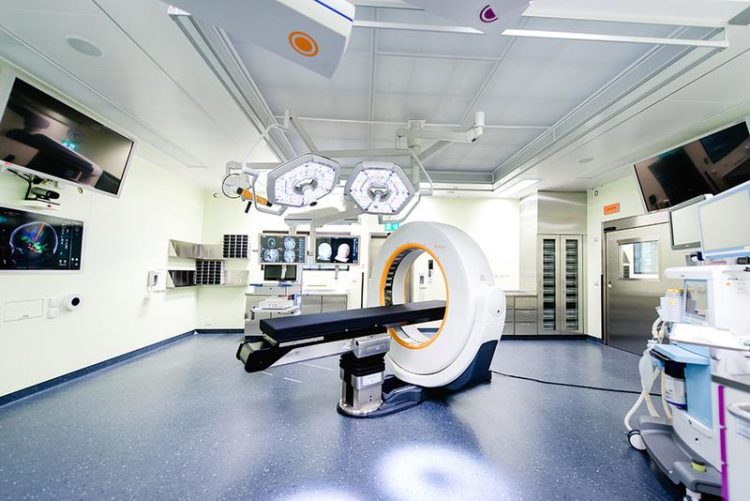Operating in the operating theatre of the future

Highly modern surgical area that can be used in an interdisciplinary way, Inselspital, Berne
Beginning in the middle of February, 2017, in the Intensive Treatment, Emergency and Operation Centre (IEO) at Inselspital, Bern University Hospital, all operative specialities will have three new operation theatres available that have integrated computer tomography (CT) and magnetic resonance imaging (MRI). Together with the hybrid operating theatre, which allows for intra-operative angiography, they create an operating area that is one of a kind in Switzerland.
Project in two phases
The project “Operation with imaging” was realised in two phases. The hybrid operating theatre (phase 1) has been in operation since September 2013. With the opening of the high-precision operating theatre (phase 2), the offering for imaging modalities is expanded and completed by CT and MRI.
The high-precision operating theatre will be used for neurosurgery, orthopaedics, visceral and oral surgery, ENT surgery and urology, each in close cooperation with neuroradiology, radiology and anaesthesia.
The flexible and economical multi-room concept of the high-precision operating theatre makes great synergies possible in the use of the cost-intensive imaging for the specialties involved. “With the realisation of the high-precision operating theatre, Inselspital is taking on a pioneering role and is continuing to strengthen its position with regard to the top medical care of patients, in translational research and in cooperation with industry partners”, according to Medical Director Prof. Dr. med. Andreas Tobler.
Greater safety and better results for patients
“With the intraoperative tomographic and three-dimensional imaging and the navigational techniques associated with it in the high-precision operating theatre, surgeons can carry out imaging checks directly during the operation – and not just afterwards – and, if need be, carry out corrective measures”, explains Prof. Dr. med. Jan Gralla, Chairman and Head of the University Institute for Diagnostic and Interventional Neuroradiology. There are many complicated operations where it is sensible to have an imaging check over the progress of the operation.
“Because we now have all three major imaging technologies for all surgical areas, we can finally introduce the completion of these checks during the operation for the first time hospital-wide. That is a change in the paradigm”, Prof. Dr. med. Andreas Raabe, Chairman and Physician-in-Chief of the Department of Neurosurgery, is convinced.
Increased competitiveness
The high-precision operating theatre is much more than the construction of three additional operating theatres. It is a beacon project that extends far beyond the borders of the canton. In his talk, Director of Health Pierre Alain Schnegg emphasised the importance of such pioneering projects. He opened the high-precision operating theatre with Holger Baumann, Chairman of the Management Board; Prof. Dr. med. Andreas Tobler, Director of Medicine; Bernhard Leu, Director of Infrastructure, and Prof. Dr. med. Andreas Raabe, Chairman and Physician-in-Chief of the Department of Neurosurgery.
Contact: Prof. Dr. med. Andreas Raabe, Chairman of the Department and Physician-in-Chief of the Department of Neurosurgery, tel. +41 31 632 00 14, mail: andreas.raabe@insel.ch
Media Contact
More Information:
http://www.insel.chAll latest news from the category: Medical Engineering
The development of medical equipment, products and technical procedures is characterized by high research and development costs in a variety of fields related to the study of human medicine.
innovations-report provides informative and stimulating reports and articles on topics ranging from imaging processes, cell and tissue techniques, optical techniques, implants, orthopedic aids, clinical and medical office equipment, dialysis systems and x-ray/radiation monitoring devices to endoscopy, ultrasound, surgical techniques, and dental materials.
Newest articles

“Nanostitches” enable lighter and tougher composite materials
In research that may lead to next-generation airplanes and spacecraft, MIT engineers used carbon nanotubes to prevent cracking in multilayered composites. To save on fuel and reduce aircraft emissions, engineers…

Trash to treasure
Researchers turn metal waste into catalyst for hydrogen. Scientists have found a way to transform metal waste into a highly efficient catalyst to make hydrogen from water, a discovery that…

Real-time detection of infectious disease viruses
… by searching for molecular fingerprinting. A research team consisting of Professor Kyoung-Duck Park and Taeyoung Moon and Huitae Joo, PhD candidates, from the Department of Physics at Pohang University…





















